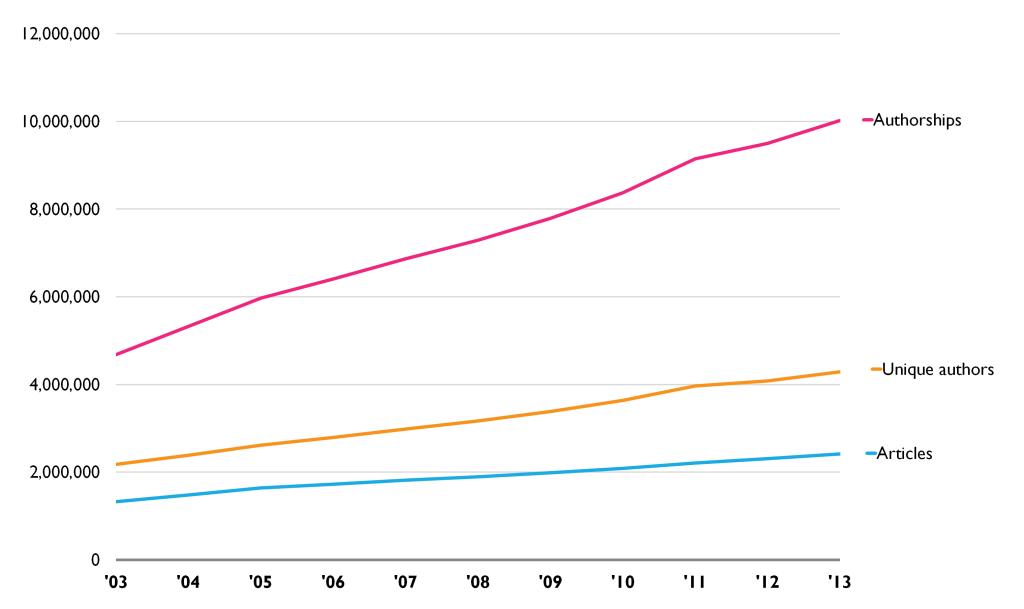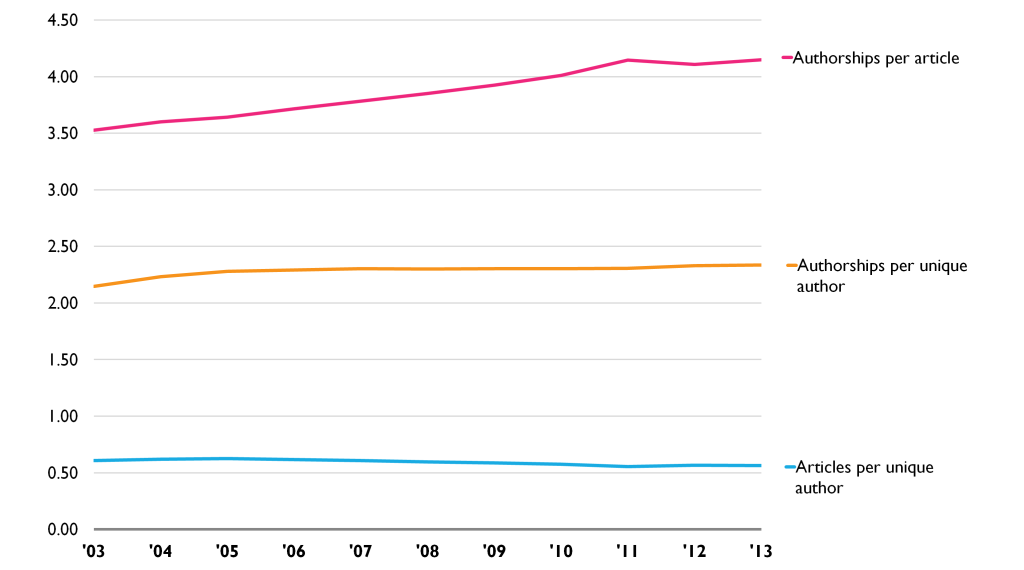By Andrew Plume and Daphne van Weijen
“Publish or perish” is a common phrase used to describe the pressure researchers feel to publish their research findings in order to stay relevant and be successful within the academic community. It’s been around a very long time, although the origins of the phrase are somewhat unclear. Some researchers attribute the phrase to Kimball C. Atwood III, who is said to have coined the phrase in 1950. A 1996 article by Eugene Garfield¹ traces the phrase back to at least 1942, while according to Wikipedia² the term was used even earlier, in a 1932 non-academic book by Harold Jefferson Coolidge (5). The phenomenon has become a focus of academic research itself, as a search for the phrase in Scopus retrieved 305 documents published on the topic from 1962 to date. On average, more than 20 articles per year were published on the topic over the past 5 years (2009 – 2013), with 37 articles alone published in 2013. Nonetheless, it seems clear that researchers suffer from this phenomenon on an increasing scale.
One common belief is that as a result of the rise of the “publish or perish” culture, and in order to remain successful in academia, each researcher is publishing more and more articles every year. But is this true? Are researchers publishing more unique articles or co-authoring more articles? One of the earliest studies in our literature search that tried to answer this question, by F.P. De Villiers, was published in 1984 and focused on changes in authorship in the South African Medical Journal from 1971 to 1982. Results of the study indicated that:
the mean number of authors per article increased from 1.77 in 1971 to 2.35 in 1982, while the proportion of articles with only 1 author decreased from 60.8% to 40.8%. Possible reasons for this are mentioned, of which the pressure to publish may not be the least.
Although this sounds intuitively plausible, these results were restricted to articles published in a single journal, and in only one research area, about 30 to 40 years ago. Since then, we’ve seen an increase in papers authored by an extremely large number of researchers, most notably the ATLAS collaboration papers published in 2008 (2,926 authors) and 2012 (3,171 authors) and a Nature article on the Initial Sequencing and Analysis of the Human Genome by the International Human Genome Sequencing Consortium with about 2,900 authors published in 2009. But the question remains how researchers are currently dealing with the increased pressure to publish. In other words, are individual researchers actually writing more articles every year, or are there just more authors writing more collaboratively? To answer this question we collected trend data from Scopus for 2003 – 2013 and checked different characteristics of authorship patterns over time; the data simply counted the number of articles (articles, reviews and conference papers) published each year and the count of authorships and unique author names associated with these. Here we use the term ‘authorships’ to define the occurrence of an individual on an article, while the concept of a ‘unique author’ reflects an individual who has appeared on one or more articles in a given period (here a single year).
Main findings
Results of our analysis show that there has been a consistent growth in the number of articles published over the past decade; from 1.3 million in 2003 to 2.4 million in 2013 (see Figure 1). At the same time, the number of authorships has increased at a far greater rate from 4.6 million in 2003 to 10 million in 2013.

Figure 1 – Growth in volume of articles published, authorships and unique authors from 2003 – 2013. Source: Scopus.
Over the past ten years or so, the number of authorships per unique author (2.31 in 2013) has increased while the number of articles per unique author (0.56 in 2013) has declined (see Figure 2), while the total number of articles published per year has increased (see Figure 1). At the same time, the average number of authorships per article has increased from 3.5 to 4.15 authors from 2003 to 2013, which suggests that authors are collaborating and co-authoring more now than they were 10 years ago. (At the same time, the percentage of single authored papers has declined from 20% in 2003 to 13% in 2013; data not shown).

Figure 2 – Authorship patterns over time (2003 – 2013). Source: Scopus.
In other words, the number of authorships per article is rising: 10 years ago, an average paper had about 3.5 authors, now it has over 4 authors. This rise in ‘fractional authorship’ (the claiming of credit for authorship of a published articles by more than one individual) is most likely driven by research collaboration, and is an efficient mechanism by which each author can increase their apparent productivity from the same underlying research contributions (i.e. articles per unique author) of 0.56 articles per unique author per year.
This means that a single author can produce a single authored article once every two years or a co-authored article with one other author every year. Now, with the rise of ‘fractional authorship’ or fractional contributions to papers, we’re seeing that the way in which authors are using this half a paper’s capacity per year is changing. A given author may achieve this output by appearing as ninth author on 5 different paper (5 x 0.1 authorships per paper), instead of co-authoring as second author on a pair of 4-author papers per year (2 x 0.25 authorships per paper).
These findings build on earlier observations⁴ in which the increases in authorships per article (at 1.9% mean annual growth rate in the period 1980-2002), authorships per unique author (at 1.2%) were contrasted by a decline in article per unique author (at -0.7%). In the current data, the comparable rates are 1.8%, 0.9% and -0.8%; suggesting the continuation of a long-term trend stretching back not just one decade but at least three.
These findings are confirmed by research in several specialty fields, including software engineering, where the average number of authors per paper has risen on average by about 0.4 authors per decade from 1970 to 2012, and pediatric surgery, which has seen a marked increase in papers authored by 6 or more authors and also in multi-national papers.
If each active author does not increase their fractional article output each year, what is driving the observed volume increase in research outputs globally? Here, the answer is quite simple – the research workforce is growing at a similar rate year-on-year to the volume of article production (at about 3-4% p.a.; data not shown), and so new entrants into research fields are responsible for creating new knowledge which eventually sees publication in the peer-reviewed literature.
Conclusion
Despite opinions to the contrary, these data suggest that there has been no apparent increase in overall productivity per active author over the last decade. Instead, authors are using their authorship potential more wisely by becoming more collaborative in the way they work, which is driving an apparent inflation in each author’s productivity as well as author bylines. Instead, the underlying driver of the volume increase in articles published is simply the introduction of new entrants/authors into the market. That is not surprising, as the total population of researchers globally continues to rise every year, and they become increasingly subject to the principles of “publish or perish”: and so the cycle continues.
Notes
¹ GARFIELD, E. “What Is The Primordial Reference For The Phrase ‘Publish Or Perish’?”. The Scientist. 1996, vol. 10, nº 12. Available from: http://www.garfield.library.upenn.edu/commentaries/tsv10%2812%29p11y19960610.pdf
² Wikipedia – http://en.wikipedia.org/wiki/Publish_or_perish
³ COOLIDGE, H. J. Archibald Cary Coolidge: Life and Letters. 1932, p. 308 (source: Wikipedia).
⁴ MOED, H.F. Citation Analysis in Research Evaluation. Dordrecht (Netherlands): Springer. 2005. ISBN 1-4020-3713-9, 346 p.
References
Did you know… “Publish or perish” has been worrying researchers for 60 years? Research Trends. 2010, nº 16. Available from: http://www.researchtrends.com/category/issue16-march-2010/
SOJKA, R.E., and MAYLAND, H.F. Driving Science With One Eye On the Peer Review Mirror. 1991.
DE VILLIERS, F.P. South African Medical Journal. 1984, vol. 66, nº 23, pp. 882-883.
The ATLAS Collaboration, et al. JINST 3 S08003. 2008. doi:10.1088/1748-0221/3/08/S08003. Available from: http://iopscience.iop.org/1748-0221/3/08/S08003/
The ATLAS Collaboration, et al. Observation of a new particle in the search for the Standard Model Higgs boson with the ATLAS detector at the LHC. Physics Letters B. 2012, vol. 716, nº 1, pp. 1–29. DOI: 10.1016/j.physletb.2012.08.020
International Human Genome Sequencing Consortium. Initial sequencing and analysis of the human genome. Nature. 2009, vol. 412, nº 565. Available from: http://www.nature.com/nature/journal/v412/n6846/extref/412565aa.html
FERNANDES, J.M. Authorship trends in software engineering. SCIENTOMETRICS. 2014. DOI 10.1007/s11192-014-1331-6.
PINTER, A. Changing Authorship Patterns and Publishing Habits in the European Journal of Pediatric Surgery: A 10-Year Analysis. European Journal of Pediatric Surgery. 2014. Available from: http://www.ncbi.nlm.nih.gov/pubmed/24918399. [Epub ahead of print].
External link
Scopus – http://www.scopus.com/
Original article in English
Como citar este post [ISO 690/2010]:




![Tracing the origins of ‘publish or perish’ [Originally published in the LSE Impact blog in July/2024] A painting by John N. Rhodes called “Study of a Skull, a Book and a Scroll of Paper” shows a human skull resting on a piece of paper wrapped around a brown cover book with a worn spine, so that you can see the seams.](https://blog.scielo.org/en/wp-content/uploads/sites/2/2024/07/WYL_LMG_027_27-001_thumb.jpg)
![Where to start with AI in research management [Originally published in the LSE Impact blog in December/2024] Image generated by Google DeepMind. The image has a purple background and you can read “How do large language models work?” with a brief description below.](https://blog.scielo.org/en/wp-content/uploads/sites/2/2024/12/AI-Research-Magagement-LSE-Impact-1-150x150.jpg)
![Funders support use of reviewed preprints in research assessment [Originally published by eLife in December/2022] eLife logo](https://blog.scielo.org/en/wp-content/uploads/sites/2/2022/11/eLife-logo_thumb.jpg)










Read comment in Portuguese, by Kenneth Camargo: http://blog.scielo.org/blog/2014/10/02/publicar-ou-perecer-o-crescimento-do-autor-fracionado-publicado-originalmente-na-newsletter-elsevier-research-trends-issue-38/#comment-7954